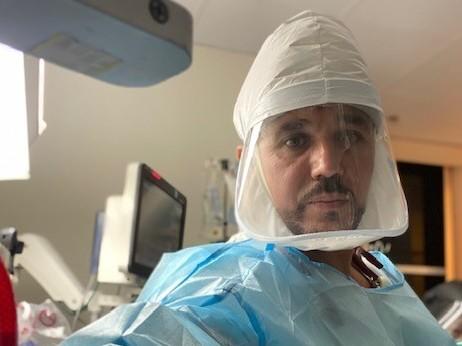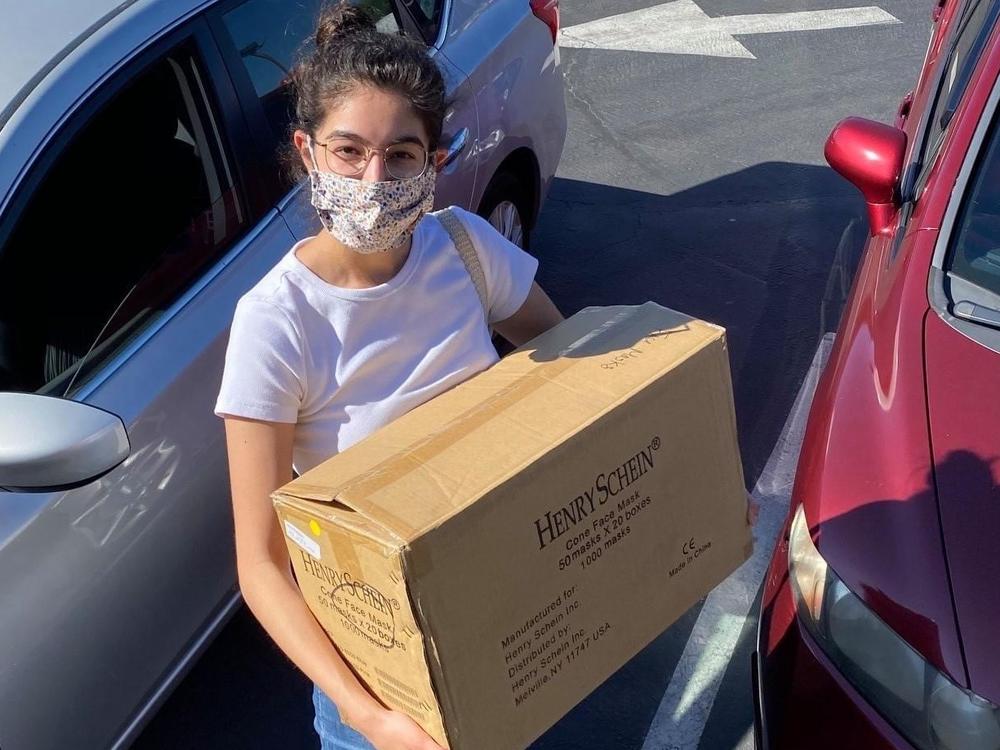Section Branding
Header Content
Trying To Assess COVID's Impact On Arab-American Communities Is Complicated
Primary Content
Dr. Hassan Fehmi started his podcast, Arab American Cafe, in October 2020 because he felt like Arab American perspectives were not widely represented in the podcasting industry. Initially, the English and Arabic conversations focused on politics, but soon enough they started talking about the pandemic and other health care issues affecting the community.
"My partner and I are healthcare professionals, so it only made sense that we start talking about health care," says Fehmi, a nephrologist and specialist in kidney disease based in Dearborn, Mich., home to the country's highest concentration of Arab American communities. "We were actually able to share with our audience some of the relevant information about COVID."
One of their recent episodes provided answers to listeners about COVID-19 vaccines and masking among other public health questions in Arabic.
"It's not only because we are Arab Americans and we care about our community. It's because we are doctors and we care about the community at large," he says. "You can't have a group of individuals who are at risk of having all of those problems and don't really try to spend some time and energy to understand them."
He found that people who are mostly Arabic speakers had fewer resources for information, especially earlier on in the pandemic. They relied on Arab satellite channels, social media, or messaging platforms, like Whatsapp, where misinformation was widespread. Much of the needed information is easy to find in English, but not the same could be said for Arabic.
"There was some concerted effort on our part as doctors and the local organizations and our community, at least here in southeast Michigan, to actually start targeting this community with the correct information," Fehmi says.
Arab communities in the U.S. have significant COVID high-risk factors, according to Fehmi. But it's difficult to understand how much Arab Americans and other people with roots in the Middle East or North Africa (MENA) have been impacted by the COVID-19 pandemic.
"We don't have data. We don't have a checkmark that says MENA or Arab American," Fehmi says. "When somebody gets admitted to the hospital, it's very hard to identify who they are if they are unable to identify themselves."
Dr. Hassan Bencheqroun, an interventional pulmonary and critical care physician, based in San Diego County says that he and several colleagues started noticing late last year that Arab American and immigrant communities were disproportionately impacted by COVID-19 in terms of infections and hospital visits. In the case of Arab communities, he saw entire families come to the emergency room together.
His colleague, Dr. Raed Al-Naser, president of the San Diego Chapter of the National Arab American Medical Association, contacted other Arab American doctors in different parts of the country, such as Michigan, New York and New Jersey. They saw similar trends.
"It's very anecdotal because we don't have specific studies, but those that work in the Intensive Care Unit, we started to notice in some chapters, especially on the East Coast and and so on, there's anywhere between seven to 10% up to 11% of the admissions to the ICU are of Arab Americans," Bencheqroun says.
Arab Americans and the MENA checkbox
The problem is two-fold. Arab Americans and people with roots in the Middle East or North Africa are currently classified as white by standards set by the White House Office of Management and Budget. All federal agencies — including the U.S. Census Bureau, the country's largest statistical organization — must follow these standards and some individual hospitals, municipalities and counties that follow federal standards do the same.
But with no separate checkbox for MENA origins on the census and other government forms, understanding the exact size of the population is difficult. This can mean that the impact of the COVID-19 pandemic on Arab communities can be hard to measure.
Although there has been a decades-long push by advocacy groups such as the Arab American Institute to add MENA as a category for ethnicity, the Census Bureau decided against it under the Trump administration in 2018.
"The continued absences of this ethnic category contributes to erasing us, our living, working," Michigan Democrat Rep. Rashida Tlaib said last year during a U.S. House Oversight and Reform Committee hearing on the census.
Tlaib, who is Palestinian American, said that she did not see herself represented on the census form.
"You are making us invisible," she said to then-Census Bureau Director Steven Dillingham, adding that she doesn't tell other people how to identify themselves.
The lack of a separate MENA checkbox is important to address especially because it's related to how the community can receive federal funding, Tlaib said, as reported by NPR in 2020. It's also crucial to determining language assistance resources, along with health research, and generally how the community is going to be treated.
Higher risk, yet invisible
Bencheqroun says that there is a prevalence of pre-existing conditions such as high blood pressure, high body mass index (BMI), and cardiovascular diabetes in Arab communities. A high rate of smoking is also prevalent among many Arab Americans.
"There is a lot of diversity in the Arab American community. I don't want to brush all the Arab American community with one brush," Fehmi says.
More recent immigrants and refugees, who lack social or economic structures to protect them, are currently the most at risk, according to Al-Naser.
"This particular group has really special needs. They lack the financial resources. They usually live under poverty level. They are not well insured, and they are less educated in general," Al-Naser says. "This is the most vulnerable group to health care disparities," he says. "And their needs have been denied by this unjust classification."
In addition to being at a higher risk, there are other barriers that prevent Arab immigrants and refugees from seeking help.
"Immigrant and refugee community members have been on the front lines of this pandemic," says Zahra Ali, development and communications manager at the Arab-American Family Support Center, a nonprofit organization providing services to immigrant and refugee families in New York City, many of whom are Arab.
Ali says that many immigrants and refugees work in the foodservice sector or hospitality industries, where there are no options to work remotely. The difficulty of social distancing on the job is further compounded by the fact that many of these workers live in multigenerational homes and overcrowded dwellings, making it more difficult to contain infections.
According to a recent report released by the Arab-American Family Support Center, 26% of respondents indicated that they experienced COVID-19 symptoms or tested positive for the disease. Many felt reluctant to get tested due to the lack of medical access and fear of being asked about their immigration status or other immigration-related repercussions.
Community members and organizations try to fill the gap
Ramah Awad, a community organizer with Majdal Center, which is an Arab resource and community center in El Cajon, says that her organization partnered with San Diego County to ensure public health information was relayed to their communities in effective ways through a community health worker.
"The [Centers for Disease Control and Prevention] and the county have materials in Arabic, but there was still this gap in information, and so we were seeking to fill that gap," Awad says.
In Southeast Michigan, there was a similar effort as well when physicians and local organizations started noticing that some Arab community members were not getting information from trusted sources, according to Fehmi.
But there's only so much community organizations can do to help Arab communities without proper data collection. Awad says it's hard to find out more about the needs of Arab communities or basic information about their education levels. In turn, it's challenging to shape outreach efforts.
"If there's not the data to back that up, then we are oftentimes going off of informal needs assessment, anecdotes from individual community members," Awad says. "But with the data, I think it would empower us to better apply for funding, get grants, develop programming, develop services that are meeting the specific needs."
To some advocates, collecting more precise census data about Arab Americans is important to understanding public health inequalities among other issues. The hope is it could lead to a better allocation of resources.
Hadia Bakkar is an intern on NPR's National Desk.
Copyright 2021 NPR. To see more, visit https://www.npr.org.


